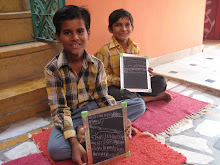A hearty chunk of the work that Pamela (our gorgeous new development director) and I do here in the land of red, white and blue is plan. We love to plan, to chip away at bold, foolish, pie-in-the-sky ideas until they've been hashed into fully articulated, achievable action maps. In our last conference, we planned fundraising initiatives and website pages, newsletter templates and Rajasthani education databases. Then, before signing off, we planned when and what we'd plan for our next planning meeting.
The toughest, tenderest slice of our planning pie is the on-the-ground material -- the new math curricula, the teacher training modules, the student assessment evaluations. This piece of programmatic forecasting is particularly tricky to navigate because our planning context could not be further removed from the implementation context. We dream and scheme and formulate ideas at dining room tables, in libraries exploding with books, over $3 coffees, or lying in comfy, warm beds. Our programs are implemented in a pocket of the world where meals are eaten on the floor, there are no libraries, $3 could feed a large family for three days, and beds are blankets spread across concrete or sand. Our planning is thousands of geographic and cultural miles away from our programming.
Every single plan we implement has at least 15 hitches, 11 provisions, and more often than not, a total overhaul. When theory hits the blacktop, the complexity of culture, poverty, and human existence spills and slops all over neatly categorized charts and lists. Which sometimes leaves us feeling like our plans would be best used to wrap dead fish. And maybe they are.
But, just as our students are constantly learning and engaging, as our we in our knowledge of what works and what does not. With each plan, we inch (sometimes at what feels like a molasses pace) ever closer to crafting programs that hold water, can withstand the barrage of learning styles and cultural and human nuances that hit it the moment it walks through the classroom door. When we close the book and wipe the dust off our hands after wrapping up a planning session, we know that we have poured the best of what we have to offer into that particular piece of programming. And, inevitably, it will crash and burn or crash, dust itself off, and figure out how to stand. But it will never be as flawless as we feel it is when we complete it in the US.
So what does it all mean? That we are perpetually naive or culturally incapable of creating ABC classes in a cozy corner of the world for a tough, rough corner of the world? I don't think so. I think it means that our best has to keep on getting better, grittier, tighter, more honed and toned, sensitive and aware. It means that we have to be a learning organization, able to take unexpected, perhaps less-than-ideal outcomes and translate them into lessons learned for the next round. And our planning sessions are where we realize how much we've learned. Of course, our implementation is when we realize how much further we have to go.
But we know that with The Merasi School, we're drawing a drawing that hasn't been drawn. So some plans are tossed to the dead fish, but others are packed with enough risk, passion, and durability that they might be able to contribute to etching out the picture of educational equality.
Subscribe to:
Post Comments (Atom)


No comments:
Post a Comment